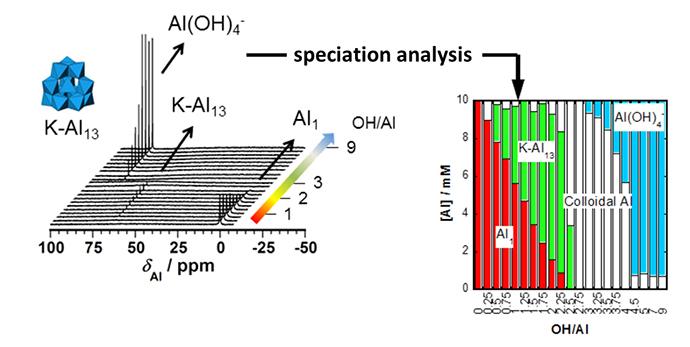Tracking the aluminum used to purify tap water

This is an analysis using 27Al qNMR (quantitative NMR) spectroscopy. Each spectrum can be measured in just three minutes. Credit: Kobe University
These findings can potentially be used in developing efficient and environmentally-conscious coagulants for water treatment. The findings were presented on May 29, 2016 at the 76th Japan Society for Analytical Chemistry Symposium.
In order to provide clear, safe tap water it is necessary to remove particles called colloids from raw water. These particles are very small, between nanometer order and micrometer order in diameter. Polychlorinated aluminum is used as a coagulant in the water treatment process to collect and dispose of these particles. However, aluminum ions can be toxic for fish and inhibit plant growth. The Japanese Water Works Law specifies that aluminum concentration in water must be limited to below 0.1ppm (1:10,000,000).
Various hydrolyzed species of aluminum ion can be detected in water. Until now the “ferron method”, involving pigments and absorption meters, has been widely used to calculate the concentration of these compounds. However, this method has some disadvantages: the analysis takes several hours and the results often contain errors.
Associate Professor Maki's research group optimized NMR¹ equipment to develop an analysis method called “27 Al qNMR (quantitative NMR) spectroscopy” that accurately measures the abundance of each aluminum compound. Notably, measurements using this analysis method can be carried out in just three minutes, and the concentration of hydrolyzed species can be calculated to within a very small margin of error in all pH ranges.
After the agglomeration mechanism of sludge including the aluminum ion was analyzed, the group discovered that when there is a high concentration of aluminum ions, after roughly 100 minutes a Keggin-type tridecameric cluster (K-Al13 ) is formed, and after a few months polymerization occurs.
As well as making it easier to measure the concentration of aluminum ions in water, this new analysis method has also clarified the structural changes aluminum ions undergo over time. These findings could potentially contribute to the development of high-performance, environmentally-conscious coagulants that can act more efficiently on colloids.
###
¹NMR spectroscopy
An acronym of Nuclear Magnetic Resonance. This method analyses molecular compounds at the atomic level by putting nuclei in a magnetic field and recording their resonance frequency. Most analyses use dipolar nuclei involving carbons and protons, but this method uses the quadrupolar nuclei of aluminum. This is the world's first reported example of fixed-quantity NMR spectroscopy on quadrupolar nuclei.
Media Contact
All latest news from the category: Life Sciences and Chemistry
Articles and reports from the Life Sciences and chemistry area deal with applied and basic research into modern biology, chemistry and human medicine.
Valuable information can be found on a range of life sciences fields including bacteriology, biochemistry, bionics, bioinformatics, biophysics, biotechnology, genetics, geobotany, human biology, marine biology, microbiology, molecular biology, cellular biology, zoology, bioinorganic chemistry, microchemistry and environmental chemistry.
Newest articles

Combining robotics and ChatGPT
TUM professor uses ChatGPT for choreographies with flying robots. Prof. Angela Schoellig has proved that large language models can be used safely in robotics. ChatGPT develops choreographies for up to…

How the Immune System Learns from Harmless Particles
Our lungs are bombarded by all manner of different particles every single day. Whilst some are perfectly safe for us, others—known as pathogens—have the potential to make us ill. The…

Biomarkers identified for successful treatment of bone marrow tumours
CAR T cell therapy has proven effective in treating various haematological cancers. However, not all patients respond equally well to treatment. In a recent clinical study, researchers from the University…





















